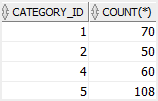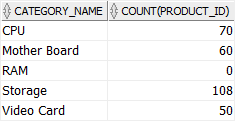Summary
: in this tutorial, you will learn how to use the Oracle
COUNT()
function to get the number of items in a group.
Oracle COUNT() function syntax
The Oracle
COUNT()
function is an
aggregate function
that returns the number of items in a group.
The syntax of the
COUNT()
function is as follows:
COUNT( [ALL | DISTINCT | * ] expression)Code language: SQL (Structured Query Language) (sql)
The
COUNT()
function accepts a clause which can be either
ALL
,
DISTINCT
, or
*
:
-
COUNT(*)function returns the number of items in a group, includingNULLand duplicate values. -
COUNT(DISTINCT expression)function returns the number of unique and non-null items in a group. -
COUNT(ALL expression)evaluates the expression and returns the number of non-null items in a group, including duplicate values.
If you don’t explicitly specify
DISTINCT
or
ALL
, the
COUNT()
function uses the
ALL
by default.
Note that, unlike other
aggregate functions
such as
AVG()
and
SUM()
, the
COUNT(*)
function does not ignore
NULL
values.
Oracle
COUNT()
examples
Let’s take some examples of using the
COUNT()
function.
A)
COUNT(*)
vs.
COUNT(DISTINCT expr)
vs.
COUNT(ALL)
Let’s
create a table
named
items
that consists of a
val
column and
insert
some sample data into the table for the demonstration.
CREATE TABLE items(val number);
INSERT INTO items(val) VALUES(1);
INSERT INTO items(val) VALUES(1);
INSERT INTO items(val) VALUES(2);
INSERT INTO items(val) VALUES(3);
INSERT INTO items(val) VALUES(NULL);
INSERT INTO items(val) VALUES(4);
INSERT INTO items(val) VALUES(NULL);
SELECT * FROM items;
Code language: SQL (Structured Query Language) (sql)
The following statement uses the
COUNT(*)
function to return the number of rows in the
items
table including
NULL
and duplicate values:
SELECT
COUNT(*)
items;
Code language: SQL (Structured Query Language) (sql)
The following statement uses the
COUNT(DISTINCT val)
to return only the number of distinct and non-null rows from the
items
table:
SELECT
COUNT( DISTINCT val )
items;
Code language: SQL (Structured Query Language) (sql)
The following statement uses the
COUNT(ALL val)
function to return the number of non-null rows in the
items
table, considering duplicates.
SELECT
COUNT( ALL val )
items;
Code language: SQL (Structured Query Language) (sql)
B) Simple Oracle
COUNT()
example
The following example returns the number of rows in the
products
table:
SELECT
COUNT(*)
products;
Code language: SQL (Structured Query Language) (sql)
C) Oracle
COUNT()
with
WHERE
clause example
If you want to find the number of products in the category id 1, you can add a
WHERE
clause to the query above:
SELECT
COUNT(*)
products
WHERE
category_id = 1;
Code language: SQL (Structured Query Language) (sql)
D) Oracle
COUNT()
with
GROUP BY
clause example
To find the number of products in each product category, you use the following statement:
SELECT
category_id,
COUNT(*)
products
GROUP BY
category_id
ORDER BY
category_id;
Code language: SQL (Structured Query Language) (sql)
In this example,
-
First, the
GROUP BYclause divides the products into groups based on the product category (category_id). -
Second, the
COUNT(*)function returns the number of products for each group.
E) Oracle
COUNT()
with
LEFT JOIN
clause
The following examples get all category names and the number of products in each category by joining the
product_categories
with the
products
table and using the
COUNT()
function with the
GROUP BY
clause.
SELECT
category_name,
COUNT( product_id )
product_categories
LEFT JOIN products
USING(category_id)
GROUP BY
category_name
ORDER BY
category_name;
Code language: SQL (Structured Query Language) (sql)
F) Oracle
COUNT()
with
HAVING
clause example
The following statement retrieves category names and the number of products in each. In addition, it uses a
HAVING
clause to return the only category whose number of products is greater than 50.
SELECT
category_name,
COUNT( product_id )
product_categories
LEFT JOIN products
USING(category_id)
GROUP BY
category_name
HAVING
COUNT( product_id ) > 50
ORDER BY
category_name;
Code language: SQL (Structured Query Language) (sql)
G) Using Oracle
COUNT()
and
HAVING
clause to find duplicate values
You can use the
COUNT()
function and a
HAVING
clause to find rows with duplicate values in a specified column.
For example, the following statement returns the contacts’ last names that appear more than once:
SELECT
last_name,
COUNT( last_name )
contacts
GROUP BY